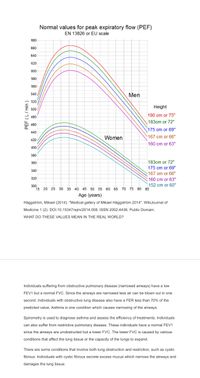
Human Anatomy & Physiology (11th Edition)
11th Edition
ISBN: 9780134580999
Author: Elaine N. Marieb, Katja N. Hoehn
Publisher: PEARSON
expand_more
expand_more
format_list_bulleted
Question
I need help.

Transcribed Image Text:Normal values for peak expiratory flow (PEF)
EN 13826 or EU scale
680
660
640
620
600
580
560
540
Men
520
Height
500
190 cm or 75"
480
183cm or 72"
460
175 cm or 69"
440
167 cm or 66"
160 cm or 63"
Women
420
400
380
360
183cm or 72"
175 cm or 69"
340
167 cm or 66"
160 cm or 63"
152 cm or 60"
320
300.
15 20 25 30 35 40 45 50 55 60 65 70 75 80 85
Age (years)
Häggström, Mikael (2014). "Medical gallery of Mikael Häg
ggström 2014". WikiJournal of
Medicine 1 (2). DOI:10.15347/wjm/2014.008. ISSN 2002-4436. Public Domain.
WHAT DO THESE VALUES MEAN IN THE REAL WORLD?
Individuals suffering from obstructive pulmonary disease (narrowed airways) have a low
FEV1 but a normal FVC. Since the airways are narrowed less air can be blown out in one
second. Individuals with obstructive lung disease also have a FER less than 70% of the
predicted value. Asthma is one condition which causes narrowing of the airways.
Spirometry is used to diagnose asthma and assess the efficiency of treatments. Individuals
can also suffer from restrictive pulmonary disease. These individuals have a normal FEV1
since the airways are unobstructed but a lower FVC. The lower FVC is caused by various
conditions that affect the lung tissue or the capacity of the lungs to expand.
There are some conditions that involve both lung obstruction and restriction, such as cystic
fibrous. Individuals with cystic fibrous secrete excess mucus which narrows the airways and
damages the lung tissue.
PEF (L/min )

Transcribed Image Text:ACTIVITY II Respiratory Volume and Lung Capacity
Spirometry is the classic pulmonary function test. A spirometer is an instrument used to
measure how much air and how quickly air is expelled after a deep inhalation. The
measurements can be used to calculate how efficiently and how quickly the lungs can be
filled upon inspiration and emptied during expiration. The most common measurements
obtained from a spirometer are listed below.
. VC Vital Capacity-- Maximal amount of air exhaled steadily from full inspiration to
maximal expiration
I FVC Forced vital capacity-- The total amount of air that you blow out in one
breath
· FEV1--Forced expiratory volume in one second--the amount of air you can
blow out in one second.
An individual with normal lungs and airways can blow out most of the
air from the lungs in the first second
I FER Forced expiratory ratio--(FEV1/FVC)x100
• Percentage of the FVC expelled in the first second of a forced
expiration
PEF Peak expiratory flow--Peak expiratory flow in liters per minute
The spirometer measures peak expiratory flow, a useful indicator of lung function to assess
conditions such as asthma. Peak flow readings are achieved by standing or sitting upright,
taking a deep breath, and blowing out through the spirometer as fast as possible.
Peak flow measurements are compared to other individuals for your age and height. See
the diagram below to see how age influences peak expiratory flow.
Why would someone have a higher than normal peak flow?
A lower than normal peak flow?
How does age appear to influence peak expiratory flow? Why do you think this is?
Expert Solution
This question has been solved!
Explore an expertly crafted, step-by-step solution for a thorough understanding of key concepts.
This is a popular solution
Trending nowThis is a popular solution!
Step by stepSolved in 2 steps

Knowledge Booster
Learn more about
Need a deep-dive on the concept behind this application? Look no further. Learn more about this topic, biology and related others by exploring similar questions and additional content below.Similar questions
- i need a paper on ptsdarrow_forwardKEY: Hydrophobic interactions: Salt bridge: Covalent bonds: Hydrogen bonding: Metal ion coordination: 9. 10What components of the plasma membrane might you drug interact with? Explain can use as many components as you need (may need more or less). Component 1 and why: Component 2 and why: Component 3 and why:arrow_forwardCan you help me with this picturearrow_forward
arrow_back_ios
SEE MORE QUESTIONS
arrow_forward_ios
Recommended textbooks for you
 Human Anatomy & Physiology (11th Edition)BiologyISBN:9780134580999Author:Elaine N. Marieb, Katja N. HoehnPublisher:PEARSON
Human Anatomy & Physiology (11th Edition)BiologyISBN:9780134580999Author:Elaine N. Marieb, Katja N. HoehnPublisher:PEARSON Biology 2eBiologyISBN:9781947172517Author:Matthew Douglas, Jung Choi, Mary Ann ClarkPublisher:OpenStax
Biology 2eBiologyISBN:9781947172517Author:Matthew Douglas, Jung Choi, Mary Ann ClarkPublisher:OpenStax Anatomy & PhysiologyBiologyISBN:9781259398629Author:McKinley, Michael P., O'loughlin, Valerie Dean, Bidle, Theresa StouterPublisher:Mcgraw Hill Education,
Anatomy & PhysiologyBiologyISBN:9781259398629Author:McKinley, Michael P., O'loughlin, Valerie Dean, Bidle, Theresa StouterPublisher:Mcgraw Hill Education, Molecular Biology of the Cell (Sixth Edition)BiologyISBN:9780815344322Author:Bruce Alberts, Alexander D. Johnson, Julian Lewis, David Morgan, Martin Raff, Keith Roberts, Peter WalterPublisher:W. W. Norton & Company
Molecular Biology of the Cell (Sixth Edition)BiologyISBN:9780815344322Author:Bruce Alberts, Alexander D. Johnson, Julian Lewis, David Morgan, Martin Raff, Keith Roberts, Peter WalterPublisher:W. W. Norton & Company Laboratory Manual For Human Anatomy & PhysiologyBiologyISBN:9781260159363Author:Martin, Terry R., Prentice-craver, CynthiaPublisher:McGraw-Hill Publishing Co.
Laboratory Manual For Human Anatomy & PhysiologyBiologyISBN:9781260159363Author:Martin, Terry R., Prentice-craver, CynthiaPublisher:McGraw-Hill Publishing Co. Inquiry Into Life (16th Edition)BiologyISBN:9781260231700Author:Sylvia S. Mader, Michael WindelspechtPublisher:McGraw Hill Education
Inquiry Into Life (16th Edition)BiologyISBN:9781260231700Author:Sylvia S. Mader, Michael WindelspechtPublisher:McGraw Hill Education

Human Anatomy & Physiology (11th Edition)
Biology
ISBN:9780134580999
Author:Elaine N. Marieb, Katja N. Hoehn
Publisher:PEARSON

Biology 2e
Biology
ISBN:9781947172517
Author:Matthew Douglas, Jung Choi, Mary Ann Clark
Publisher:OpenStax

Anatomy & Physiology
Biology
ISBN:9781259398629
Author:McKinley, Michael P., O'loughlin, Valerie Dean, Bidle, Theresa Stouter
Publisher:Mcgraw Hill Education,

Molecular Biology of the Cell (Sixth Edition)
Biology
ISBN:9780815344322
Author:Bruce Alberts, Alexander D. Johnson, Julian Lewis, David Morgan, Martin Raff, Keith Roberts, Peter Walter
Publisher:W. W. Norton & Company

Laboratory Manual For Human Anatomy & Physiology
Biology
ISBN:9781260159363
Author:Martin, Terry R., Prentice-craver, Cynthia
Publisher:McGraw-Hill Publishing Co.

Inquiry Into Life (16th Edition)
Biology
ISBN:9781260231700
Author:Sylvia S. Mader, Michael Windelspecht
Publisher:McGraw Hill Education